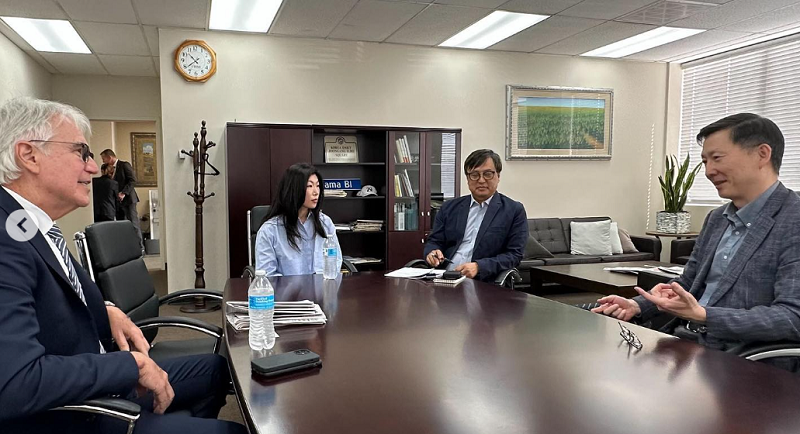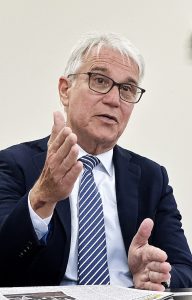
Los Angeles County, home to the largest Korean American community in the United States, has a larger population and economy than 42 states.
District Attorney George Gascón, who was an officer on the scene of the L.A. riots which began on April 29, 1992, and is now the head of the District Attorney’s Office, the county’s top prosecuting authority, visited the Korea Daily newsroom on April 28 to share his thoughts on the riots, street crime and homelessness 31 years later.
Responding to criticism that he has a “soft on crime” policy, he explained that he is pursuing a “smart on crime” policy, and also expressed his deep regret over the murder of Lee Dal-geun who was stabbed to death in a broad daylight last year, which shocked the Korean-American community.
The following are edited excerpts of the interview with Gascon.

A. That’s right. I was a deputy chief of the LAPD in 1992 and saw the Korean-American community up close, and then I was the police chief in Mesa, Arizona, and then I was the district attorney in San Francisco, and then I came back to my hometown of LA as district attorney. They were all great experiences for me.”
Q. You took office during the pandemic.
A. When I took office in 2020, we were facing a pandemic. Crime across the country was on the rise and prisons were facing all kinds of problems. Now that the pandemic is over, things are starting to get back to normalcy. The economy is also returning to normal, except for inflation. Hate crimes, which spiked during the pandemic, are like a “cancer” on communities. The incident in Monterey Park was the worst. Mike Fong has introduced state bills on guns (AB 732 and AB 733) and we are hopeful that if they pass, a lot will change.”
Q. This past weekend was the 31st anniversary of the April 29 riots. Do you think justice has been served for many of the people involved in the riots?
A. Clearly, our local government and leadership was a ‘failure’ for everyone at the time. The criminals in question were back on the streets a short time later. Many of the residents who lost their homes and businesses could not get back any of what they had lost. If we still haven’t recovered enough, I’d call it a failure.”
Q. When you were elected District Attorney two years ago, you ran on a platform of long-term “justice reform,” saying that the current system only encourages street crime. Based on your experience, what makes you believe that reform is necessary?
A. When I was a sergeant in the LAPD in 1992, I watched how the Rodney King case and riots unfold. As I watched Korean-American small businesses targeted by rioters, I realized that the system brought out the worst in people. The leadership at the time didn’t understand the situation, and the interconnected communities of blacks, Koreans, and Latinos all turned against each other. The vicious cycle continued as young black men were sent in and out of prison for simple offenses. Overall, the leadership was still racist. It’s not much different now. When you have a president who is openly vilifying a particular ethnic group, it’s only natural that the streets would be dangerous, and the current policy of the District Attorney’s office is a very natural response to that situation.
Q. Does it mean that the county prosecutor’s current “soft” prosecution policy will remain unchanged next year?
A. The policy direction will continue to evolve. Currently, 85% of offenders sentenced to jail time are released back into the community. But most of them end up in a different environment. Many have drug and mental health problems, are unable to find employment, and return to a life of crime. This creates victims. Unlike us, other developed countries are dealing with this problem in a more effective way. Of course, they should be held accountable and punished for their crimes. But if they are thrown back into an environment where they are likely to reoffend, our society is not making any fundamental progress.
Q. Is there any alternative?
A. That’s why we want to take a ‘smart’ approach to these crimes and offenders, not a ‘soft’ one. It’s the same with homelessness. If you don’t have a social ‘safety net’, the community is not going to get better. It costs $100,000 to keep a person in jail for a year. If they’re addicted to drugs, have mental health issues, or are elderly, it can cost up to $500,000. All of these systems are still hard at work draining our tax dollars.
Q. You’ve mentioned on several occasions that violent crimes like murder, guns, and even driving style have gotten out of hand. Shouldn’t tougher penalties lead the way, if necessary, and shouldn’t “reforms” be flexible to fit the situation?
A. As I outlined in my mid-term report, the prosecution rate is the same as it was under Jacquelyn Lacey[former district attorney of LA County]. We are prosecuting felonies and misdemeanors at the same rate and frequency. I can’t speak to misdemeanors in L.A. because they are handled by the City Attorney’s Office, but felonies in L.A. are still handled the same way. Hate crime prosecutions are also much higher at 90%, compared to the statewide average of 50%. But the crux of the problem is after the punishment. We believe that reducing recidivism is the key to public safety. For example, it’s not just a matter of randomly deploying police to ticket and arrest people for careless or dangerous driving. It’s about changing and improving the infrastructure conditions in the area to encourage drivers to follow the system and drive safely. I think the answer is to stabilize these systems over time.
Q. Some have pointed out that prosecutors should use their prosecutorial power to promote public safety, but they approach it with the mindset of a social worker or health department official.
A. When I was elected district attorney, I emphasized the need for specialized psychiatric wards in detention centers and prisons. This is because mental health cannot be taken care of in prisons. However, there is still no budget for this. In the meantime, the jails are overcrowded and are forced to discharge inmates early. There are more than 17,000 people in the county jails, which are designed to hold 12,000. As a result, the average one-year felon is released after serving 10% of their sentence. That’s the reality. County government needs to be held accountable. No matter how much you punish and prosecute people, if they think they’re going to be released again soon, you’re not going to reduce crime. The problem is the system.
Q. There have been two recall campaigns, and Korean Americans have participated in them. What do you say to these Korean-Americans who are still concerned about their safety?
A. First of all, I would like them to realize that the prosecution rate is the same as it was under the previous district attorney. I would also like to remind them that the policies and activities of the police and prosecutors are not the only reason for the increase in crime. There are other invisible social factors that contribute to the increase in crime. The fact that the incidents that troubled us a decade ago are still with us today shows that we have not addressed the root causes of the problem. We will be more proactive in doing what prosecutors can do to keep people safe.
Q. What do you see as the biggest of those “social factors” – a revolutionary change in policy, or a better mayor, governor, or supervisor?
A. I think [LA] Mayor Bass is doing a great job of identifying and approaching the root of the problem. But you can’t expect homelessness to be solved in six months or a year. There’s a tremendous amount of taxpayer money being spent, but it’s not a quick fix. The state spends $16 billion a year on its prison system. But most criminals are back on the streets. Policies and elections are only a good start.
Q. The murder of Lee Dal-geun last year shocked the Korean-American community. He was stabbed to death in broad daylight and was a typical first-generation immigrant. Many wondered what could have been done to prevent it. Was there any follow-up with Mr. Lee’s family?
A. This was a very unfortunate case. We contacted the family and informed them of our victim protection and care programs. Unfortunately, we are unable to bring their father back to them, but we will continue to provide them with support and care until they recover from the trauma. Currently, the county prosecutor’s office issues nearly 100,000 indictments a year. If we start with individual cases and say, “If we had locked up the offender longer, this wouldn’t have happened,” it might be easier to find cases where that’s not the case. We need to look at how criminals became murderers, but the idea that arresting and prosecuting them will prevent other crimes doesn’t make sense as a matter of criminal justice. As chief prosecutor, I promise to track down, prosecute, and bring criminals to justice.
BY INSEONG CHOI [support@koreadaily.com]

![Korean homeless residents face eviction from LA-subsidized housing Hyun Park(left), a long-term resident of a homeless rental housing unit, speaks with KYCC Director Rick Kim (far right). [Sangjin Kim, The Korea Daily]](https://www.koreadailyus.com/wp-content/uploads/2025/06/0630-homeless-100x70.jpg)


